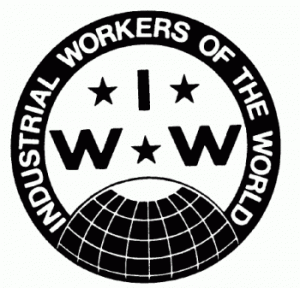 |
| IWW logo |
Founded in 1905, the organization was always small, with a peak membership numbering in the tens of thousands during the 1910s, but the Wobblies successfully agitated among many more workers. Influenced by European syndicalist ideas about remaking society, they sought to create "one big union" that would bring together all laborers. They offered the vision of a nation in which wages and private profits were abolished, and business-dominated government gave way to "industrial democracy."
Ferocious opponents of the American Federation of Labor, which organized only craft workers, the IWW focused on the semiskilled and unskilled: mass-production factory hands, loggers, longshoremen, migrant farm workers, and domestic servants. Their interest in organizing African Americans and newly arrived immigrants was particularly unusual in an era of racial and ethnic polarization.
Unlike other organized labor groups, the IWW rejected the idea of collective bargaining to improve wages and working conditions. They refused to sign contracts, arguing that this would impede workers' ability to take action.
  |
They also were uninterested in traditional political activism, because many of the groups to whom they appealed were unable to vote. Instead, they wanted to foment change by creating a revolutionary proletarian culture.
Wobblies typically went out in "flying squadrons" of mobile agitators, riding the rails, sleeping in hobo "jungles" on the outskirts of towns, and preaching the IWW message to all those among whom they lived and worked. The Wobblies were known for their constant singing while they traveled or were in jail.
Although they often used inflammatory rhetoric, this was paired with acts of nonviolent civil disobedience. One attention-grabbing tactic was their "free speech" fight. The point was to educate onlookers about their constitutional rights and the unjustness of authorities.
A Wobbly would stand on a soapbox on a street corner, delivering a harangue. If he or she was arrested, another Wobbly would immediately take up the speech and be arrested in turn, until the local jail was flooded and the public expense became prohibitive.
The IWW also taught various forms of nonviolent resistance on the job. Workers would surreptitiously slow down their pace of production, or they might deliberately feed a machine too quickly so that the wheels became clogged.
 |
| IWW Poster |
The IWW pioneered the use of the sit-down strike; the first recorded in U.S. history occurred in 1906 in Schenectady, New York, when 3,000 workers trained by Wobblies simply sat down in their factory and refused to leave.
While most labor organizations have a formal structure with elected officials, a central headquarters, and union locals, the IWW was the opposite: Members often boasted that they were all leaders and that their "locals" could be found under any traveling member's hat.
This decentralization made it possible for the Wobblies to agitate among a wide variety of laborers across the country. In 1912 they enjoyed a major success when they led a strike at textile mills in Lawrence, Massachusetts.
They managed to sustain cross-ethnic solidarity among 23,000 workers during the difficult winter months, not only winning concessions on pay and work hours but also highlighting issues such as dangerous workplace conditions and child labor. In 1913 they led a similar strike in Paterson, New Jersey, which became a cause célèbre among New York City's leftist intellectuals, culminating with a dramatic worker pageant held at Madison Square Garden.
The Wobblies ultimately failed to build a long-term movement. Workers gravitated to the IWW when they wanted to fight for "bread and butter" issues, but upon attaining these immediate material goals they rarely stayed committed to the Wobbly call for revolution.
The IWW was viewed as a dangerous organization by business interests, and Wobbly agitators were sometimes subject to brutal repression. For example, in 1916 in Everett, Washington, a deputized crowd at a dock fired on a steamship full of singing Wobblies, killing or wounding several dozen.
When the United States entered World War I in 1917, the IWW had succeeded in organizing copper mines in the West to the extent that national production was threatened. In the heated wartime atmosphere, the IWW was denounced on the Senate floor as standing for "Imperial Wilhelm's Warriors." The Woodrow Wilson administration decided to prosecute Wobblies for espionage and "criminal syndicalism."
In September 1917 the Justice Department conducted raids on every significant IWW hall, and by the end of the year more than a hundred prominent organizers were locked up. In a mass trial in 1918, the government was unable to show that the Wobblies had committed any crimes, instead focusing on their "seditious and disloyal" teachings.
Most were convicted, and over the next several years the organization expended its energies and meager financial resources fighting the convictions. Internal schisms and further legal repression left the IWW impotent by the mid-1920s.